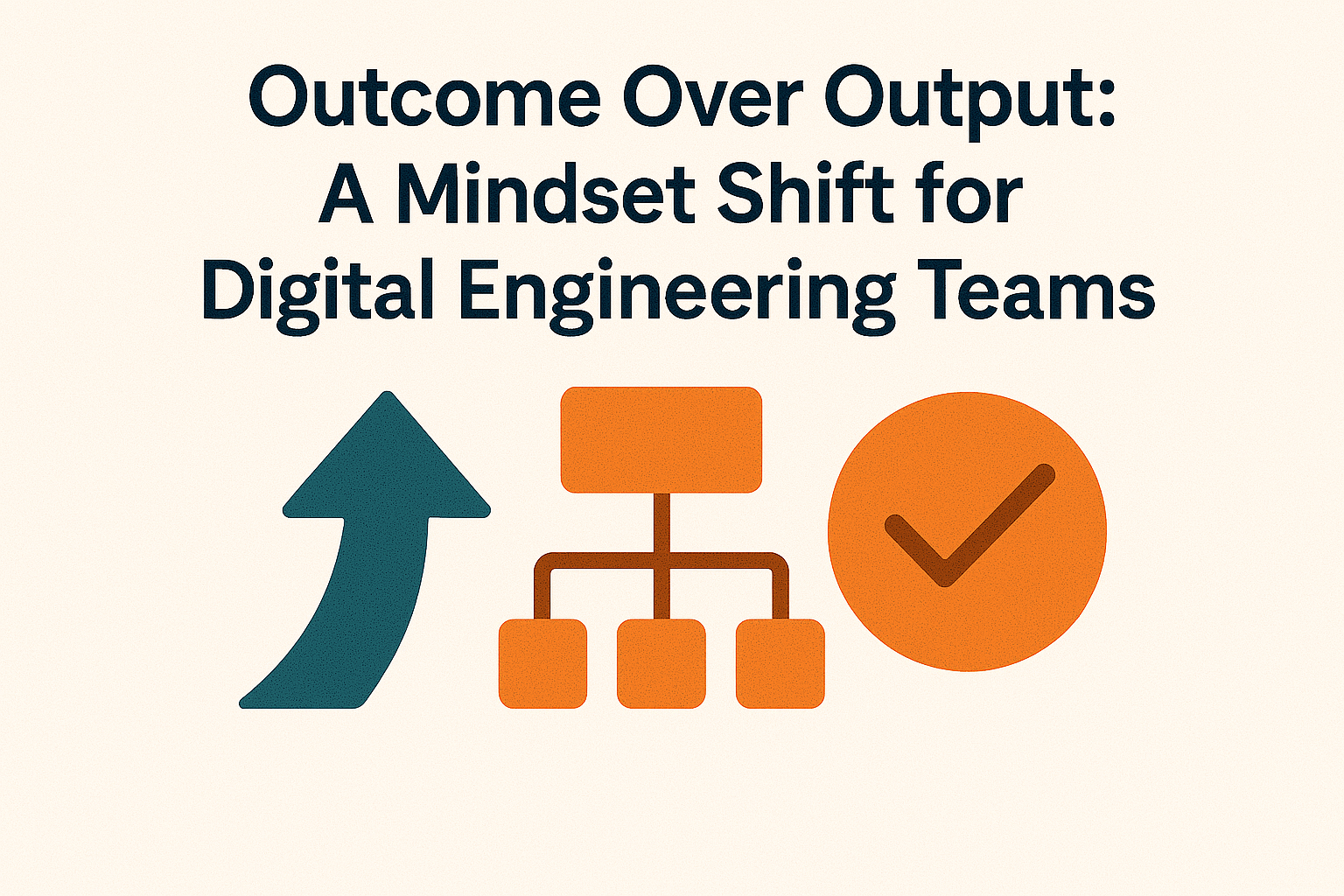Outcome Over Output: A Mindset Shift for Digital Engineering Teams

In fast-paced digital environments, where agile ceremonies, sprints, and roadmaps define the rhythm of work, it’s easy for engineering teams to become fixated on output - the visible, tangible artefacts of delivery: lines of code, user stories closed, deployments made.
But delivering more doesn’t always mean delivering better.
Modern digital engineering teams must move beyond a task-centric mentality and embrace a more strategic mindset: outcome over output. This is the shift from simply building things right to ensuring we are building the right things - measured not by how much we produce, but by the value we create.
This mindset doesn’t just lead to better products. It fosters stronger collaboration, deeper ownership, and more meaningful impact across engineering teams.
Understanding Output vs. Outcome
To make the shift, we first need to define the difference.
Output is what we do: features built, tickets closed, code shipped. It’s activity-based.
Outcome is what we achieve: customer satisfaction, reduced friction, improved performance, increased revenue, faster recovery. It’s impact-based.
You can have high output and poor outcomes. In fact, many teams do - building features no one uses, maintaining legacy systems no one values, or fixing problems that don’t really matter.
True excellence lies in measuring success by outcomes, not activity.
Why This Shift Matters
1. It Aligns Engineering with Business Impact
Engineering is a value creator - not just a service provider. When teams focus on outcomes, they connect their work to real business goals, from improving conversion rates to increasing customer retention. This clarity unlocks purpose and sharper prioritisation.
2. It Unlocks Innovation
Output-driven teams are incentivised to deliver what’s asked. Outcome-driven teams are empowered to ask, “What’s the best way to solve this?” - often uncovering simpler, smarter, or more innovative solutions.
3. It Increases Autonomy and Accountability
When teams are trusted with outcomes instead of outputs, they own why they’re doing the work - not just what to do. This autonomy fuels intrinsic motivation and a culture of accountability.
4. It Avoids the Feature Factory Trap
Without clear outcomes, teams fall into the trap of shipping features endlessly, without understanding their impact. Outcome focus creates space for experimentation, iteration, and - crucially - stopping work that isn’t valuable.
What It Looks Like in Practice
Moving to an outcome-oriented culture requires changes in how we plan, lead, and deliver. Here's what that looks like:
✅ Define Success in Terms of Impact
Start with problem statements and desired outcomes, not pre-defined features. For example:
❌ “Build a dashboard”
✅ “Enable operations to identify and act on anomalies within 5 minutes”
Make outcomes measurable - use leading indicators, KPIs, or user feedback.
✅ Empower Teams to Solve, Not Just Deliver
Frame work around goals and trust engineers to co-create the best path forward. Encourage cross-functional collaboration during discovery. Involve engineering in defining the problem - not just executing the solution.
✅ Use Output as a Means, Not the End
Velocity and throughput still matter - but only as a signal of delivery health. Don’t confuse busyness with progress. Combine delivery metrics with outcome indicators like feature adoption, error reduction, or improved user satisfaction.
✅ Create Feedback Loops with Real Users
Outcomes can’t be assumed - they must be validated. Build mechanisms to gather insight post-release: analytics, qualitative feedback, support trends. Use this data to inform iteration or pivoting.
✅ Celebrate Outcomes, Not Just Effort
Recognise and reward impact. Highlight stories where engineering work led to measurable improvements. This reinforces the right behaviours and shifts the internal narrative.
Shifting the Culture
This transition is as much cultural as it is procedural. Here’s how leaders can guide it:
Model outcome-focused thinking in how you speak, plan, and measure.
Ask different questions: not “When will it ship?” but “How will we know it made a difference?”
Create psychological safety so teams feel empowered to challenge scope and offer alternatives.
Balance freedom with focus - clear boundaries around outcomes with autonomy in approach.
Key Takeaways
✅ Output is easy to measure, but it doesn’t guarantee value. Outcome is the real measure of engineering effectiveness.
✅ High-performing teams solve problems, not just build features. They care about impact, not just activity.
✅ Shifting to outcome-first thinking requires clarity, trust, and collaboration - across product, engineering, and business stakeholders.
✅ Celebrate learning and impact, not just delivery speed.
✅ When engineers are focused on outcomes, they bring more creativity, ownership, and strategic thinking to their work.
Final Word
In digital engineering, delivery is table stakes. What truly differentiates great teams is their ability to deliver the right things, in the right way, for the right reasons.
Shifting from output to outcome isn’t just a process change - it’s a mindset shift. It transforms engineering from a function that does work to one that drives impact.
Because in the end, the goal isn’t to build more.
It’s to build what matters.
Engineering leader blending strategy, culture, and craft to build high-performing teams and future-ready platforms. I drive transformation through autonomy, continuous improvement, and data-driven excellence - creating environments where people thrive, innovation flourishes, and outcomes matter. Passionate about empowering others and reshaping engineering for impact at scale. Let’s build better, together.
